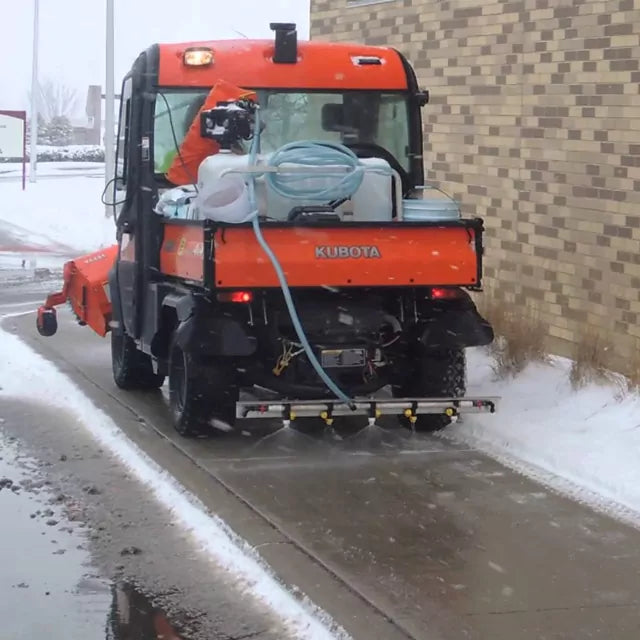Ice Melt Application Strategy

Ice control on parking lots requires some capital investment. While a truck is needed, it does not necessarily need to be a truck outfitted with a plow. In fact, there are some compelling arguments that having a truck plow and salt is not an effective use of resources. The initial venture into deicing services begins with the acquisition of a tailgate-mounted, electrically driven spreader holding 700 to 900 lbs. of deicing material. These units are not terribly expensive and allow the small operator to enter the deicing business with a minimal capital investment – usually less than $2,000.
The downside to this method of deicing parking lots and driveways is the deicing material must be manually loaded into the hopper, thus requiring someone to work outside in the elements several times during a typical evening plowing. Generally, the material is loaded onto the truck in 50- or 80-lb. bags, manually opened and then dumped into the hopper. While inefficient from a labor standpoint, margins are still much higher than plowing.
The next step in building your deicing service is to purchase and mount a slide-in, V-box spreader. These spreaders are hydraulically or electrically driven units that hold from 1.5 to 7 tons of material. Some manufacturers make units that fit nicely on a three-quarter ton pickup, but care must be taken not to overload the hopper. The additional weight can cause problems with the truck's suspension, causing damage to the undercarriage and axles of the vehicle. Once the spreader is mounted on the truck, whether on the tailgate or as a V-box, it is filled with salt and the mechanism turned on, spreading the salt while the truck drives over the pavement.
Most spreaders are equipped with mechanisms that allow the operator to control the amount of salt being applied. Once the operator determines how wide the salt path is, he or she can determine how many passes are required to coat the entire lot with salt or deicing product. As your company continues to grow, using spreaders mounted on the rear boom of a backhoe can also reduce labor costs since a single operator with a pusher on the front of a backhoe can clear and deice the lot simultaneously.

Anti-icing
Deicing is the most common means of removing ice from a customer's facility or residence. Deicing is the application of an ice-melting material after ice has formed on the pavement, sidewalk or other traffic area. However, you can apply salt or an alternative deicing product prior to the snow or ice event. This technique is called anti-icing and it has grown in popularity, especially among contractors using liquid deicing materials. Salt, sitting on the paved surface, is inert unless moisture is introduced and comes in contact with the granular rock salt.The nice thing is you can achieve this result by using only one-third the amount of product required for traditional deicing. If it does not continue to snow after completion of plowing operations, there is often no need to reapply salt to the cleared surface. If an additional application of salt is required, desired results can be achieved with considerably less material than you would have needed had you not been proactive. All things considered, the astute contractor can actually use half the normal amount of salt by having a pre-salting program in place. Most contractors who pre-salt also make a very light application of salt after the plowing has been completed.
How much is enough?
Establishing a pre-salting program can conserve salt usage in the long run. When discussion occurs about the use of rock salt (sodium chloride) and its distribution to the pavement surface, there are always arguments as to how much product needs to be applied to the pavement surface to achieve the desired results. Don Walker from the University of Wisconsin, one of the leading authorities on deicing in the country, stated that 200 lbs. of rock salt applied evenly on 1 acre of surface is adequate to reduce a light to medium buildup of ice to a liquid form.
200-250 lbs. of rock salt per acre is all that is required to reduce a light accumulation
Various DOT studies indicate that in a light-icing situation, 200 to 250 lbs. of rock salt per acre is all that is required to reduce a light accumulation of ice to water at approximately 28 degrees F. Under these conditions, the melting process will take 45 to 60 minutes to complete. A heavy accumulation of ice may require as much as 350 lbs. of rock salt per acre. This may seem absurdly low, but these low application levels are attainable.
In fact, recent studies indicate as little as 75 lbs. of rock salt will address a light icing on 1 acre of pavement. Unfortunately for contractors, the V-box, slide-in spreaders can only be calibrated down to about 300 lbs. per-acre distribution. There are spreaders on the market that can go as low as 75 lbs. per acre, but the cost of these units is well over $50,000. Normally, this is out of a commercial plowing contractor's price range. Contractors often charge for half-ton and full-ton applications of rock salt for an acre of parking surface. More often than not, contractors apply more salt than is necessary. This has some negative consequences, including reduction of profits, the potential to overcharge customers and doing more harm to the environment than is necessary. The next time you see a white parking lot the day after a snowstorm, it is likely the contractor over applied salt to the lot.
Editor’s note: The following was excerpted from John Allin’s best-selling second edition of “Managing Snow & Ice.”

Powering Productivity
Our blog powers your productivity through new product reviews, industry news, tips & tricks, business advice, and more!

Russo News
Stay up-to-date on the latest company news and learn more about our history.

Leave a comment